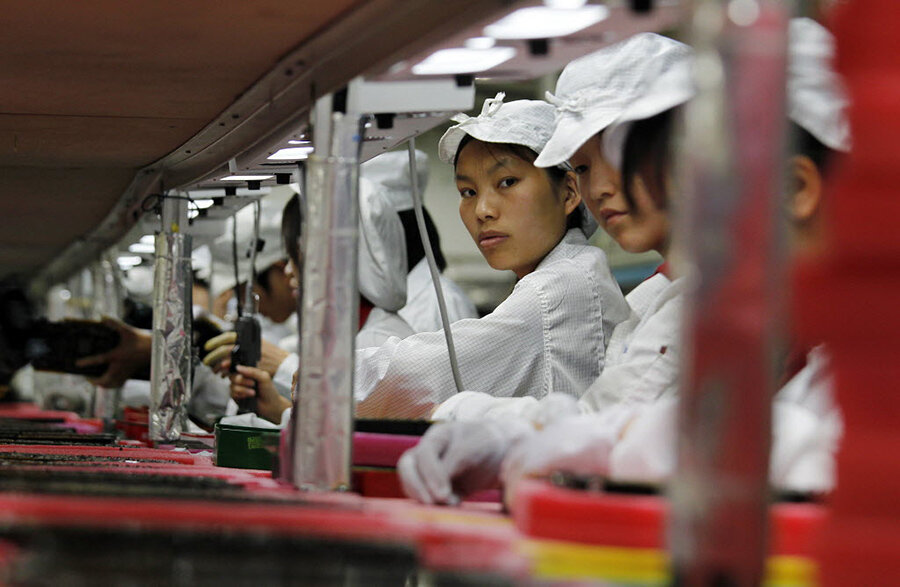If Foxconn moves to US: Could that raise the cost of your iPhone?
Loading...
A growing parade of companies such as General Motors, Carrier, China’s SoftBank, and now Taiwanese electronics manufacturing contractor Foxconn Technology Group, are boosting their US investments – raising the prospects for more US factory jobs in parts of the country that desperately need them.
Is this an emerging Trump-prodded shift that could ultimately halt the exodus of American jobs? Perhaps, but probably not, say business management experts.
“It’s possible that it could lead to a manufacturing renaissance; I’m just really skeptical,” says Ann Harrison, a professor of multinational management, business economics, and public policy at Wharton business school at the University of Pennsylvania.
Foxconn, the biggest private employer in China and the assembler of Apple’s iPhones there, is in talks with the Pennsylvania Department of Community and Economic Development about locating what is reportedly a $7 billion factory to assemble display screens for televisions and possibly the iPhone.
According to Nikkei Asian Review, Foxconn’s chairman Terry Gou said the potential investment will be done in partnership with Apple, and could go to Pennsylvania or whatever US state provides attractive enough incentives to win the deal. It would create 30,000 to 50,000 jobs, Mr. Gou has said, though it’s not clear whether those will be on the factory floor, or include the service and parts-making jobs that will be needed to support the new facility.
Despite criticism that President Trump takes credit for economic development wins that were in the works long before he won the election, it’s hard to imagine that his combative rhetoric, his attacks of Apple and others for making products abroad, and threats of 45 percent tariffs on imports from China and other countries, are not partly responsible for a spate of "Made in America" corporate decisions.
Gou told Reuters that the deal has been in the works for a long time, though Pennsylvania’s office of economic development said in an email to The Christian Science Monitor that Gou contacted its office in Taiwan in December to inquire about incentive programs available for companies that want to locate in the state. The company already had invested in research and design operations in Pittsburgh, as the Monitor has reported.
Big tax, infrastructure, and workforce incentives from states could further entice Foxconn – or any other company weighing the costs of expanding in the United States. This, on top of Mr. Trump's promises to reduce corporate taxes and to chip away at the labyrinth of corporate regulations, could help balance the equation in favor of US manufacturing again, notes Morris Cohen, a manufacturing and logistics professor at Wharton.
“I think companies are looking at the environment and thinking we’re being encouraged to do this by our government in ways we’ve never been encouraged before, so companies are lining up to say we want to be cooperative here, we don’t want to be viewed as a bad corporate citizen,” says Professor Cohen.
But without government incentives, the numbers typically don't add up to make manufacturing in the US profitable. Labor here is expensive (relative to most nations) and there’s little infrastructure for large-scale factory operations, many argue. Ultimately, consumers would bear the brunt of rising production costs. As The Wall Street Journal reported in November, the price of a 32-gigabyte iPhone 7 would grow by an estimated $90 if it were assembled in the US from parts that were also made here.
But even if costs do rise for some consumer products, perhaps the value of employing Americans who lost their factory jobs to globalization would outweigh the higher prices, points out Professor Harrison.
“It’s likely that if you add up all the costs in terms of the increased price people will pay for electronics, that will be bigger than the number of jobs and wages created,” she says. “But maybe America is in a position where it would give more weight to people who lost their jobs than to people who want to buy phones.”
In the short term, says Harrison, Trump’s intimidation tactics could work. Possibly even without the tariffs on imports that many economists worry could spark a trade war that could undermine American exports. "If it would lead to a large-scale resurrection of manufacturing sector without tariffs, that would be an amazing outcome," she says.
But the long-term trend is toward automation in manufacturing plants, where robots are expected to continue replace humans doing repetitive work, she notes. “We need to think of better solutions,” she says, such as reorienting our economy towards high-wage service jobs.








